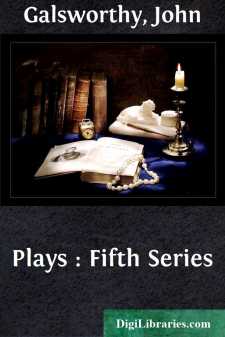Categories
- Antiques & Collectibles 13
- Architecture 36
- Art 48
- Bibles 22
- Biography & Autobiography 813
- Body, Mind & Spirit 142
- Business & Economics 28
- Children's Books 17
- Children's Fiction 14
- Computers 4
- Cooking 94
- Crafts & Hobbies 4
- Drama 346
- Education 46
- Family & Relationships 57
- Fiction 11829
- Games 19
- Gardening 17
- Health & Fitness 34
- History 1377
- House & Home 1
- Humor 147
- Juvenile Fiction 1873
- Juvenile Nonfiction 202
- Language Arts & Disciplines 88
- Law 16
- Literary Collections 686
- Literary Criticism 179
- Mathematics 13
- Medical 41
- Music 40
- Nature 179
- Non-Classifiable 1768
- Performing Arts 7
- Periodicals 1453
- Philosophy 64
- Photography 2
- Poetry 896
- Political Science 203
- Psychology 42
- Reference 154
- Religion 513
- Science 126
- Self-Help 84
- Social Science 81
- Sports & Recreation 34
- Study Aids 3
- Technology & Engineering 59
- Transportation 23
- Travel 463
- True Crime 29
John Galsworthy
John Galsworthy (1867-1933) was an English novelist and playwright renowned for his series of novels collectively titled "The Forsyte Saga," which offers a critical portrayal of the upper-middle-class in Britain during the late 19th and early 20th centuries. He was awarded the Nobel Prize in Literature in 1932 for his distinguished art of narration which takes its highest form in "The Forsyte Saga." Galsworthy was also a social activist, advocating for prison reform, women's rights, and animal welfare throughout his life.
Author's Books:
Sort by:
by:
John Galsworthy
SCENE I It is six o'clock of a November evening, in KEITH DARRANT'S study. A large, dark-curtained room where the light from a single reading-lamp falling on Turkey carpet, on books beside a large armchair, on the deep blue-and-gold coffee service, makes a sort of oasis before a log fire. In red Turkish slippers and an old brown velvet coat, KEITH DARRANT sits asleep. He has a dark,...
more...
by:
John Galsworthy
ACT I SCENE I The curtain rises on the BARTHWICK'S dining-room, large, modern, and well furnished; the window curtains drawn. Electric light is burning. On the large round dining-table is set out a tray with whisky, a syphon, and a silver cigarette-box. It is past midnight. A fumbling is heard outside the door. It is opened suddenly; JACK BARTHWICK seems to fall into the room. He stands holding by...
more...
by:
John Galsworthy
ACT I It is Ascension Day in a village of the West. In the low panelled hall-sittingroom of the BURLACOMBE'S farmhouse on the village green, MICHAEL STRANGWAY, a clerical collar round his throat and a dark Norfolk jacket on his back, is playing the flute before a very large framed photograph of a woman, which is the only picture on the walls. His age is about thirty-five his figure thin and very...
more...
by:
John Galsworthy
ACT I SCENE I The study of JOHN BUILDER in the provincial town of Breconridge. A panelled room wherein nothing is ever studied, except perhaps BUILDER'S face in the mirror over the fireplace. It is, however, comfortable, and has large leather chairs and a writing table in the centre, on which is a typewriter, and many papers. At the back is a large window with French outside shutters, overlooking...
more...
by:
John Galsworthy
ACT I The SCENE is the pretty drawing-room of a flat. There are two doors, one open into the hall, the other shut and curtained. Through a large bay window, the curtains of which are not yet drawn, the towers of Westminster can be seen darkening in a summer sunset; a grand piano stands across one corner. The man-servant PAYNTER, clean-shaven and discreet, is arranging two tables for Bridge. BURNEY, the...
more...
by:
John Galsworthy
ACT I SCENE I The scene is a well-lighted, and large, oak-panelled hall, with an air of being lived in, and a broad, oak staircase. The dining-room, drawing-room, billiard-room, all open into it; and under the staircase a door leads to the servants' quarters. In a huge fireplace a log fire is burning. There are tiger-skins on the floor, horns on the walls; and a writing-table against the wall...
more...
by:
John Galsworthy
ABOUT CENSORSHIP Since, time and again, it has been proved, in this country of free institutions, that the great majority of our fellow-countrymen consider the only Censorship that now obtains amongst us, namely the Censorship of Plays, a bulwark for the preservation of their comfort and sensibility against the spiritual researches and speculations of bolder and too active spirits—it has become time...
more...
by:
John Galsworthy
THE INN OF TRANQUILLITY Under a burning blue sky, among the pine-trees and junipers, the cypresses and olives of that Odyssean coast, we came one afternoon on a pink house bearing the legend: "Osteria di Tranquillita,"; and, partly because of the name, and partly because we did not expect to find a house at all in those goat-haunted groves above the waves, we tarried for contemplation. To the...
more...
by:
John Galsworthy
Part IIAt the door of St. George's registry office, Charles Clare Winton strolled forward in the wake of the taxi-cab that was bearing his daughter away with "the fiddler fellow" she had married. His sense of decorum forbade his walking with Nurse Betty—the only other witness of the wedding. A stout woman in a highly emotional condition would have been an incongruous companion to his...
more...
by:
John Galsworthy
PART I—SPRINGIHe walked along Holywell that afternoon of early June with his short gown drooping down his arms, and no cap on his thick dark hair. A youth of middle height, and built as if he had come of two very different strains, one sturdy, the other wiry and light. His face, too, was a curious blend, for, though it was strongly formed, its expression was rather soft and moody. His eyes—dark...
more...











